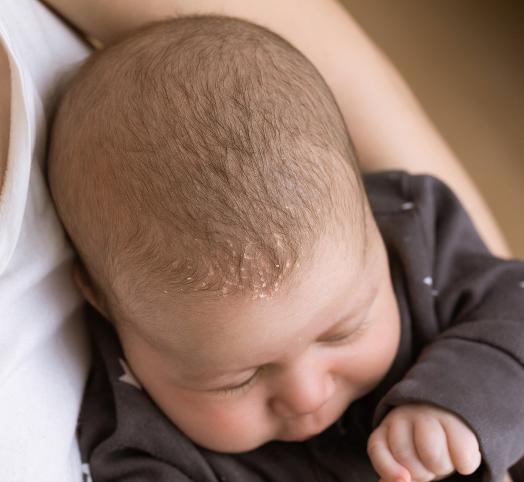Cradle Cap
Updated on March 22, 2023
Created on July 24, 2019
Find your nearest point of sale here
Updated on March 22, 2023
Created on July 24, 2019

Your baby has been with you for a few weeks now, and every day, their personality and body develop.
Especially their particularly fragile infant skin. Today you discovered some small yellow patches on their lovely head?
This is cradle cap. We’ll tell you everything you need to know to master the subject.
What is exactly Cradle cap?
First of all cradle cap is one of the common skin conditions in infants, so no need to worry!
Indeed, around two thirds of babies(1) are affected by cradle cap. Cradle cap can appear very early in the first weeks of life and last from a few days to a few months, then disappear completely at around 2 years of age, although sometimes it may last longer.
What is the relationship between the formation of these patches on your baby’s scalp and milk? Absolutely none!
So do not worry about changing your baby's diet unless your doctor recommends it. Indeed, the name in French, “croûtes de lait” or “milk crusts” comes from the resemblance of this skin condition with drops of milk that have overflowed from a saucepan and dried on the hob. As cradle cap resembles dried hardened milk, its appearance is easy to remember: small rough patches, yellowish brown in appearance and a little greasy to the touch.
They love to settle on baby’s scalp. Cradle cap sometimes descends to the eyebrows and more rarely to the body of babies, in particular the armpits or bottom. Over the course of several days, the cradle cap dries to form a crusty skin rash (also called scales) that fall off naturally.
Does baby lose a bit of hair at the same time? That goes without saying, but the hair will grow back without a problem. A last but important precision: while the crusty patches are not very nice to look at, they are superficial. Even better, cradle cap is not painful, it can only cause sensations of discomfort.
Where does Cradle Cap come from ? Since it does not come from milk, does it come from a lack of hygiene? No, not that either! Cradle cap is a somewhat like dandruff in adults. It therefore depends more on a natural skin reaction than an overlooked bath. Further proof that cradle cap is not a serious problem for your child. More specifically, cradle cap comes from excess sebum in babies. In other words the sebaceous glands, which produce the lipidic film on the skin to protect it, are very active.
Hence the appearance, in some places, of greasy areas that accumulate dead cells. Thus trapped, these cells form these small crusty patches, primarily on the scalp. So why are the sebaceous glands over-productive? Because of pregnancy hormones!
You thought you had finished with them for good? You, maybe, but not your baby who may not necessarily have eliminated all of them from his body. However, the good news is, this means that when they completely disappear, so will the cradle cap.
Meanwhile, this hyperseborrhoea promotes the development of a yeast that we all have on the skin: Malassezia Furfur. The proliferation of this yeast also contributes to the appearance of cradle cap by provoking a skin reaction in the baby.
To sum up, the maternal hormones present in your baby's body stimulate his sebaceous glands too much, which encourages the presence of Malassezia Furfur. Ideal conditions for stimulating the skin, and especially the scalp of your baby, which responds by creating cradle cap.
Sources: (1) C Moises-Alfaro et al, In J Dermatol 2002, 41, 349-351.